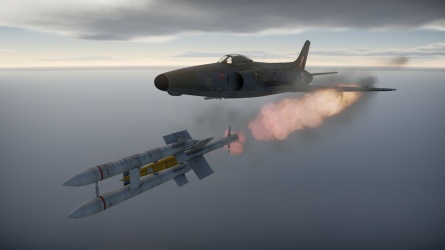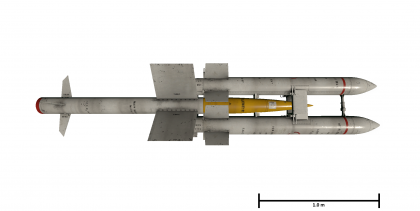Fireflash
Contents
Description
The Fireflash missile was the first air-to-air guided missile put into service with the United Kingdom’s Royal Air Force. Built by Fairey Aviation, the same company who built the Swordfish, this missile utilised radar beam riding guidance to get the missile onto a target. The odd-looking missile consists of a central dart attached to two boosters. The boosters spin-stabilize the missile in flight and propel the missile to speeds upwards of Mach 2. 1.5 seconds after launch, with fuel spent, the boosters separate and the missile would coast the rest of the way to the target, still receiving guidance from the controlling aircraft.
This missile has a very short "attention span" in that it requires the launching aircraft to basically keep the nose of the aircraft pointed at the target aircraft. The beam from the aircraft's radar will guide the missile to the target, however, the further away from the launching aircraft the missile gets, the wider the beam becomes and more difficult for the missile to continue to track. Also, if the target aircraft begins to make sudden movements, it will be difficult for the missile to keep up and sudden movements by the attacking aircraft to maintain the enemy aircraft in its sights will probably result in the missile losing the beam and it flying off until it runs out of fuel or energy and plummets to the earth.
Vehicles equipped with this weapon
General info
The main part of the missile considered the "dart" is a missile body with controllable fins, beam tracking sensors and a warhead. This portion of the missile does not have any propellent nor a motor. To produce thrust for the dart, it relies on two boosters which after firing, burn for approximately 1.5 seconds to a speed of about Mach 2, where then the boosters separate and the dart continues to be guided by the aircraft's radar beam to the target making minor adjustments as needed.
The Fireflash has a relatively short effective distance, as after separation from its boosters it no longer has a source of thrust and is reliant on its kinetic energy, once that depletes, the dart falls to the earth. Also, the farther away the dart gets from the launching aircraft, the harder time it has to maintain the beam and is likely to go astray. Quick movements of the attacking aircraft can also cause the missile to lose track of the beam and at that point, it will fly astray.
Effective damage
The Fireflash is reliant upon high explosive damage when it gets close enough to a target aircraft.
Comparison with analogues
Give a comparative description of missiles that have firepower equal to this weapon.
Usage in battles
This missile has an effective range of about 4 km (2.4 mi) before it no longer has the kinetic energy to continue. This missile is best used in short-range encounters such as head-on attacks where the enemy fighter is closing the distance rather than flying away. This missile can be used during tail chases as long as you maintain close distance and can keep the radar on the enemy long enough for the missile to acquire its target. The Fireflash is a finicky missile which requires practice and patience, though not as simple to use as other missiles found in-game, it can be a surprise to enemy fighters they are not expecting resulting in them having to go back and watching replays in unbelief to see what took them out. Having only two of these missiles to rely on will require the pilot to exercise restraint and not launch one if the chances of a hit are marginal and instead maybe turn to the 30 mm cannons instead in that instance.
| Unlike heat-seeking missiles, beam riding missiles will not trigger a missile launch warning for the enemy player. |
Pros and cons
Pros:
- Not vulnerable to countermeasures
- Do not trigger missile approach warning (MAW) systems
- Can be easier to guide than command guided missiles
- Can be used as unguided proximity rockets
- Great for head-on attacks
- Massive 20 kg warhead, third in size only to the Firestreak (22.7 kg) and Red Top (31 kg)
Cons:
- Must keep your aircraft pointing at the target
- Bad at engaging manoeuvring targets
- Anything more than gentle corrections will make missile fall out of beam and lose tracking
- Gets less accurate with increased range
- Easy to dodge if the missile is spotted
- 4 km max range then out of fuel
History
Fireflash traces its history to the immediate post-war era when the Royal Air Force began development of an air-to-air missile primarily for anti-bomber use. The initial concept, "Red Hawk", called for an all-aspect missile using beam riding guidance, similar to a number of short-range experimental systems developed during the war. As the speeds of the aircraft began to increase dramatically with the introduction of jet power, the Royal Aircraft Establishment (RAE) concluded that the limited range of the radar systems meant the pilot would only have seconds to aim and fire before their aircraft was passing the target.
Realizing that Red Hawk was beyond the state of the art, a "watered down" concept was introduced and given the name "Pink Hawk" by its designers. Instead of an all-aspect weapon, Pink Hawk would be designed for tail-chase shots against piston bombers like the Tu-4. This would give the pilot much more time to lock on their radar and fire, while still giving them enough stand-off range to remain well out of the bomber's defensive fire. Additionally, as the missile would be approaching from a very limited set of angles, the radar system was greatly simplified. The proposal was accepted in 1951 and given the official name "Blue Sky".
By this time, the RAE had come across German wartime documentation that suggested the ionized trail left by rocket motors would block radar signals. This led to the concept of using fall-away rocket motors that gave the design its unique layout. Initially the design used four cordite-powered rocket motors from the wartime RP-3, but these were later replaced by two larger custom motors known as Stork. When the Storks burned out they were ejected with an explosive bolt system, leaving the central "dart" to continue on, unpowered but free of the rocket exhaust. Given the expected low accuracy of the beam-riding guidance, a relatively large 20 kg warhead was carried. The result was a long and heavy weapon, about twice the weight of Sidewinder.
By the time Blue Sky began testing in 1953, advances in the new art of infrared guidance had led to reconsideration of the original Red Hawk all-aspect concept. Once again the technology was not up to the task, and another watered down concept emerged, Blue Jay. This appeared to be far more powerful than Blue Sky; it could be launched from any aircraft, even ones without a radar system, with the added benefit of allowing the launching fighter to turn away from the target once fired. Interest in Blue Sky dwindled, but development continued as a stop-gap weapon while Blue Jay was in development.
Testing completed in 1955 and acceptance trails began. This revealed that the missile would oscillate wildly after the rockets were ejected, and further changes had to be made. By this point development of Blue Jay was only 18 months behind Blue Sky and the Ministry of Supply (MOS) began to have serious misgivings about purchasing the system in large numbers. A production arrangement was finally agreed on and the missile became Fireflash. The first Fireflash squadron was activated on 15 August 1957.
As expected, Blue Jay closely followed Fireflash. Given the name Firestreak, it entered service the next year and Fireflash was removed from service as quickly as they could be replaced.
Media
- Videos
See also
Links to the articles on the War Thunder Wiki that you think will be useful for the reader, for example:
- reference to the article about the variant of the weapon;
- references to approximate analogues by other nations and research trees.
External links
Paste links to sources and external resources, such as:
- topic on the official game forum;
- encyclopedia page on the weapon;
- other literature.





